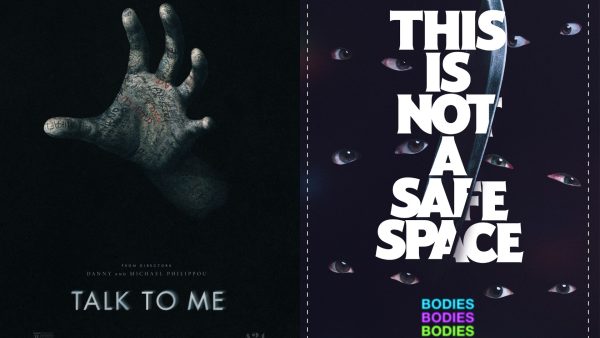
Don’t you wish you could kill your own generation? Well, wish no more; horror movies have got your back.
While many horror movies have focused on a group of teens surviving the night, none have immortalized our current generation until now.
Two movies in recent years have decided to focus on a generation that hasn’t received enough spotlight, especially in the art of monsters and things that go bump in the night.
In the summer of 2023, the movie “Talk to Me” by Danny and Michael Philippou came out with a brand-new spin on the possession story. The flick centers on a group of friends’ discovery of a party game that lets spirits possess them with an embalmed hand. However, things take a turn for the worse when the spirits refuse to let one of their friends go.
While this film is your typical possession story, it does highlight the fear and insecurity of our recent generation. The party game and spirit possession can be interpreted as a subtle allegory for drug abuse taking control of a user, with how the character treats being possessed as a fun game and an experience to get high and wasted while recording it to post on social media to show how messed up they got last night.
However, the story takes a dark turn when the character Mia, who is suffering from grief over the passing of her mother, turns to the embalmed hand and possession to deal with her issues as the spirits slowly gain control over her.
This blend of mental illness and drug abuse hits a sore spot within our generation, as these are the active issues most of our generation is dealing with. It shines a light on how easy it is to fall into a cycle of drug abuse due to untreated mental issues, and how this eventually leads to the dissolution of friendships and the loss of loved ones.
In the spring of 2022, the movie “Bodies, Bodies, Bodies” by Halina Reijn brought a new twist to the old dark house subgenre of films. When a group of 20-year-old friends are trapped within a mansion during a hurricane, a party game becomes deadly when one of the friends is found dead, and the remaining friends must distinguish between fake friends and the killer.
The flick shows how superficial relationships have become for generation Z. After the death of one of the friends, they easily turned on each other. They rely on the formation of bias, and easily blow up on each other as the situation becomes more dire. Arguments start to escalate over group chat neglect, exes and relationships, ableism, and podcasts. With friends who are pathological liars, have fragile egos, and are recovering from drug addiction, we see the dissolution of this friend group through death and murder as the underlining emotions they have against each other bubble to the surface.
These sets of films strike a chord with our current generation. It expresses the current turmoil that our generation is in with drugs, mental illness, and fragile friendships. By having these issues displayed on the big screen, it not only acknowledges these issues but also reveals that we are seen and that our struggles are real. Although there are no current solutions to these problems, it is good that film still holds a mirror that reflects life, especially ours, which is easily discarded or ignored by older generations from suffering any issues.





